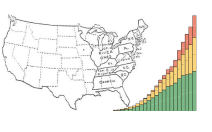As used by the Census Bureau, the term nativity refers to whether a person is native or foreign born, as defined in the introductory text for Chapter 11. The term parentage refers to the places of birth of a native person’s parents and has three basic categories: native parentage (both parents native), mixed parentage (one parent native and one parent foreign born), and foreign parentage (both parents foreign born). A question on birthplace of parents was included on the census from 1870 to 1970. Starting in 1910, census reports used the term “foreign stock” to refer to the combined population in three categories: foreign born, native of foreign parentage, and native of mixed parentage. The population not of foreign stock is native of native parentage.
The data published on the foreign-stock population were for the White population only from 1910 to 1950, reflecting the fact that the vast majority of the foreign-born population was from Europe. In addition, the census reports showed extensive data on the foreign-stock population by country of origin (country of birth of the foreign-born population and country or countries of birth of parents). For consistency, the data on the foreign-stock population from 1870 to 1970 in this chapter, which do not include data on country of origin, are limited to the White population.
Figures
